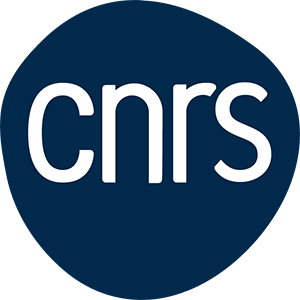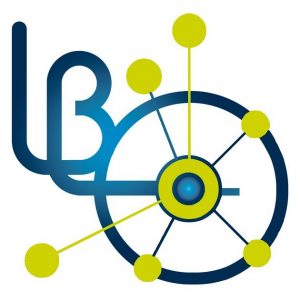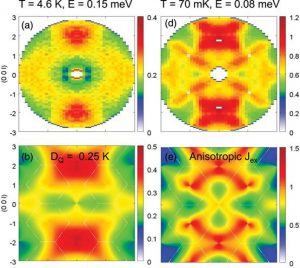A Léon Brillouin Laboratory – Condensed State Physics Unit collaboration
Terbium titanate Tb2Ti2O7 is an insulating oxide with a pyrochlore lattice (a special lattice made up of tetrahedra touching at their apex), whose geometry is such that magnetic ions (rare earths Tb) cannot find a spin configuration that satisfies all antiferromagnetic interactions at the same time. This phenomenon is known as geometric frustration, and over the past dozen years it has given rise to intense research, both theoretical (to understand frustration and its effects) and experimental (to explore these systems with all kinds of probes at very low temperatures). Terbium titanate is an extreme case, as frustration leads to a lack of magnetic order in Tb moments (or spins) down to temperatures of the order of 0.05K. But its theoretical description has so far resisted all attempts. Normally, and allowing for frustration, Tb2Ti2O7 should exhibit magnetic order below about 1 to 2K. But in fact, it remains in the “spin-liquid” state down to 0.05 K, as the spins, although interacting with each other, remain fluctuating and do not “freeze” (in a “spin-ice” state).
Neutron scattering of Tb moments enables us to explore this type of state by determining the correlations existing in the liquid spin phase, or more precisely, by tracing maps in reciprocal space that reflect these spin correlations. Theoretical models are then measured against these maps, which they are intended to reproduce, at least in outline.
Neutron scattering by the Tb moments allows the investigation of this type of state by revealing the correlations existing in the spin liquid phase, or more precisely, by plotting reciprocal space maps reflecting these spin correlations. Theoretical models are then evaluated according to these maps, which they are intended to reproduce, at least in outline.
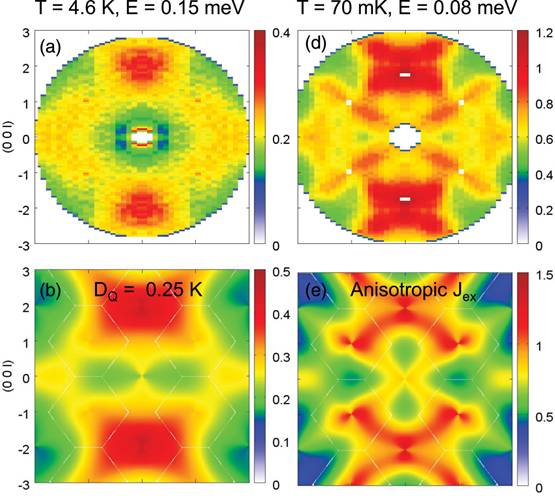
A joint LLB/SPEC experimental team (A. Gukasov, I. Mirebeau, J. Robert, S. Petit / P. Bonville) has tackled this problem by measuring inelastic and diffuse scattering maps at very low temperatures (0.07K) on the 4F and 6T2 spectrometers at Saclay (Figure 1, top), while developing a model capable of accounting for the “spin liquid” state of Terbium titanate. This model calls for a weak symmetry breaking at very low temperatures, which could be linked to the Jahn-Teller effect, to which the non-Kramers ion Tb3+ may be indebted, or to a quadrupolar order. It allows understanding of the “spin liquid” phase of Terbium titanate and, combined with another feature of pyrochloric lattices, the anisotropy of inter-ion exchange, gives a fairly good account of inelastic scattering maps (Figure 1, bottom). It also gives a good account of diffuse scattering maps at 0.07K, including those with polarization analysis, carried out at the Institut Laue-Langevin by another team (Figure 2).
The model developed by our collaboration is currently the only one to have made a breakthrough in understanding the singular behavior of terbium titanate, which has resisted all attempts at explanation for a decade. However, we believe that our model is semi-phenomenological and that a more complete theory, taking into account the complex interplay of lattice and spin degrees of freedom, remains to be developed.
References:
Tetragonal distortion yielding a two-singlet spin liquid in pyrochlore Tb2Ti2O7
P. Bonville, I. Mirebeau, A. Gukasov, S. Petit, J. Robert, Phys. Rev. B 84, 184409 (2011)
Low temperature phase diagram for the pyrochlore compound Tb2Ti2O7
P. Bonville, I. Mirebeau, A. Gukasov, S. Petit, J. Robert, J. Phys.: Conf. Series 320, 012006 (2011)
Spin dynamics in the ordered spin ice Tb2Sn2O7,
S. Petit, P. Bonville, I. Mirebeau, H. Mutka, J. Robert, Phys. Rev. B 85, 054428 (2012)
Spin liquid correlations, anisotropic exchange and symmetry breaking in Tb2Ti2O7,
S. Petit, P. Bonville, J. Robert, C. Decorse, I. Mirebeau, Phys. Rev. B 86, 174403 (2012)
Contacts:
Isabelle Mirebeau, Arsen Gukasov, Sylvain Petit, LLB – Laboratoire Léon Brillouin
Pierre Bonville, SPEC – Service de Physique de l’État Condensé
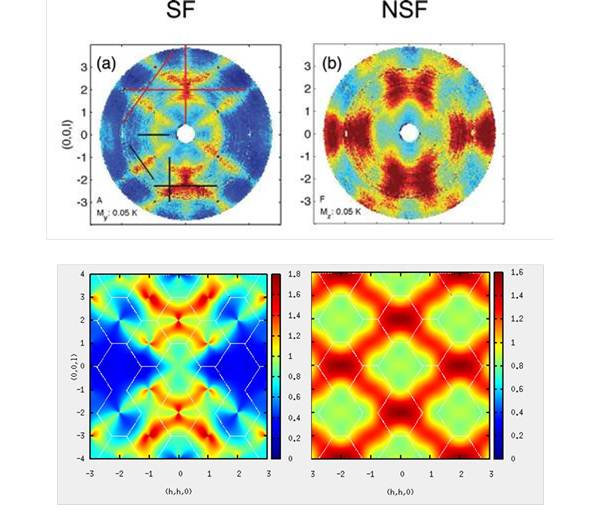
Figure 2: Diffuse scattering maps of polarized neutrons at 0.07K: comparison between experiment (top, from T. Fennell et al, PRL 109, 017201 (2012)) and theory (bottom). The initials SF (Spin-Flip) and NSF (Non Spin-Flip) refer to neutron polarization reversed or not after interaction.

